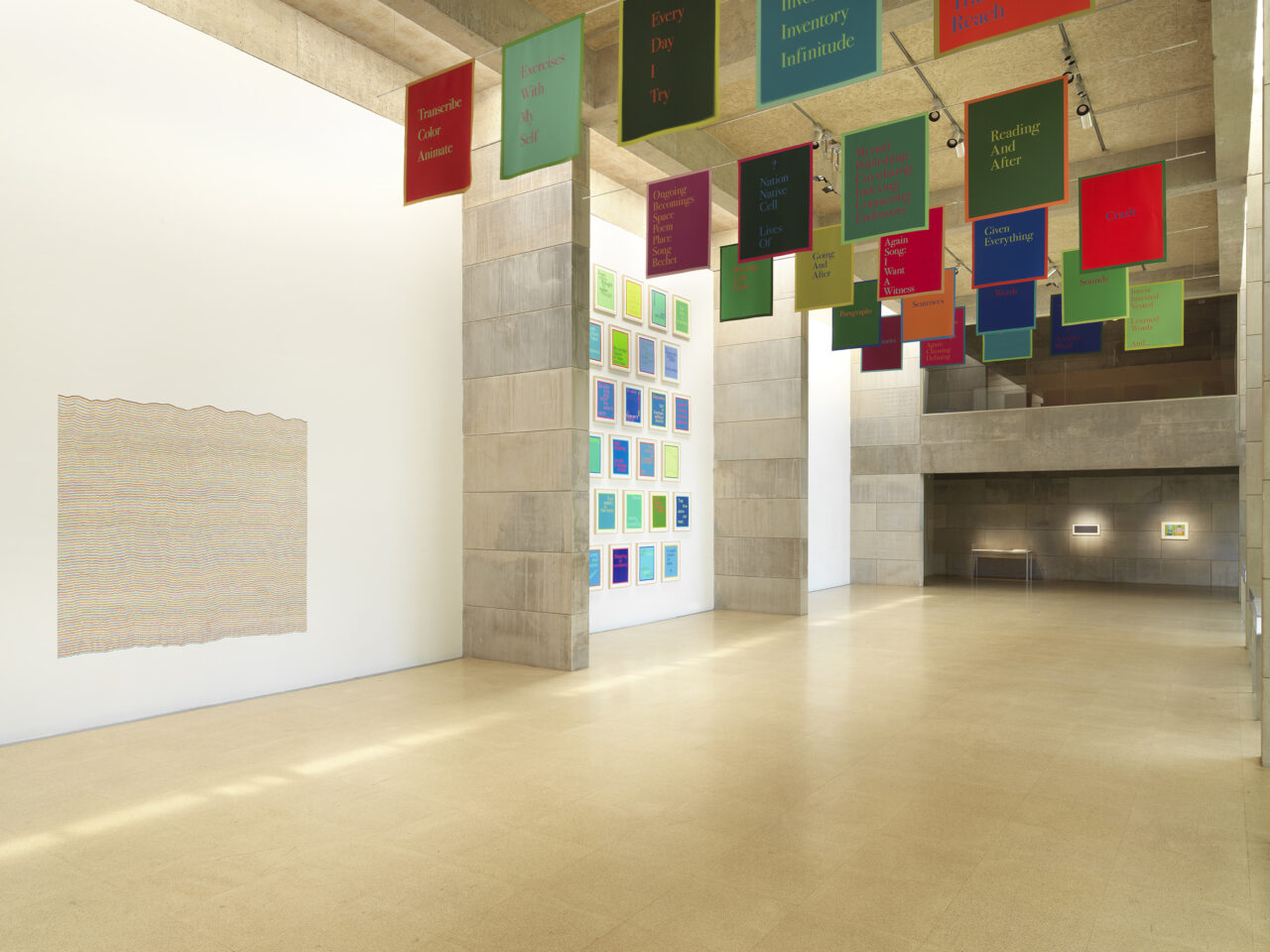Zilkha Gallery Exhibit: “No Title: Relays and Relations, Works by Renée Green and Sol LeWitt”

Artist Renée Green ’81 spoke with Associate Director of Visual Arts Benjamin Chaffee ’00 during Wesleyan’s Homecoming + Family Weekend in October. Chaffee is the curator of the exhibition “No Title: Relays and Relations, Works by Renée Green and Sol LeWitt,” on display in the Ezra and Cecile Zilkha Gallery through Sunday, December 3.
As a student at Wesleyan, Green was exposed to LeWitt’s methodologies, ethos, and ways of relating to other artists. She participated in a course taught by Professor of Art History Emeritus John Paoletti that focused on LeWitt’s art collection in collaboration with the Wadsworth Atheneum, which resulted in the exhibition “No Title: The Collection of Sol LeWitt” in the Davison Art Center in 1981. Edited by Paoletti, a catalog was published, including Green’s first published writings.
By enrolling in Paoletti’s seminar, Green wanted to learn more about what other artists’ processes entailed, and to absorb as many things as she could, eventually meeting some of the people she studied later in life. “I was exposed to rigor of a particular kind that I did enjoy,” Green said of the research she did during the seminar. She was excited about publishing, which she went on to study after Wesleyan, working at several art publishing firms in New York after college.
The current exhibition brings together works from across Green’s trajectory including the newly-created Space Poem #9 (Today), and wall drawings by LeWitt (1928-2007). LeWitt’s Wall Drawing #1120, given to Zilkha Gallery in 2004, was installed by a LeWitt studio draftsperson and 24 current Wesleyan students, and will remain on display in the second-floor lobby of the gallery, outside the Center for the Arts office, for several years.
“I’d never witnessed it before,” Green said of the surprising process of the student installation of the LeWitt drawings in September. “It’s been quite interesting to learn about LeWitt’s methods and instructions, and how these continue to be applied in the present, now that he’s no longer with us.”
Following a screening of Green’s digital film “ED/HF,” about the life and memory of German filmmaker Harun Farocki (1944—2014), a film commissioned by the Walker Art Center in 2017, Green spoke about how a conversational mode figures into her practice. “Sometimes what happens is that I’m reading something, and there’s a sentence that strikes me as being particularly alive, and I’d like to think with it,” Green said in relation to the inclusion of Farocki’s words in her film.
While at Wesleyan and attending Paoletti’s seminar, she had learned and written about conceptual artist Lawrence Weiner (1942—2021). Every Single Person (LW), a work she created in 2022 and that is on display in Zilkha Gallery, is an acknowledgment of Weiner’s work using his own words from an interview. Green stated that this work is a “portable memorial.”
At the opening reception in September, Chaffee said the current exhibition began as a spark of an idea in 2020. “How do you honor fifty years of a gallery?” Chaffee said about thinking about the 50th anniversary season of the Center for the Arts during the 2023-2024 academic year. “How do we make an exhibition that honors that legacy, not just as an idea, but in an embodied or a materialized way?” Chaffee wondered about the function of a gallery at a liberal arts university, and what it offers to students.
As a Professor in the Art, Culture, and Technology program at MIT’s School of Architecture and Planning, Green continues to be interested in the intergenerational transfer of artists’ methodologies: what similar acts of aesthetic exchange and support could be offered to younger artists today, thereby “relaying” the transmission of a related, but rethought, aesthetic impulse into the present and future.
“I think that what resulted is a show that’s less about a direct formal or aesthetic connection between two artists, and more a question about method or methodology,” Chaffee said.
“I was curious about entering into this compelling invitation,” Green said of the current exhibition at Wesleyan. “It’s always an intense process to return and to attempt to do something in a place you are familiar with in a different way.”
Both Green and LeWitt have had their work exhibited at Wesleyan previously, but never in conjunction. In addition to her senior thesis exhibition in 1981, Green was part of other group exhibitions in the Zilkha Gallery, including “Embedded Metaphor” in 1998, “The Alumni Show II” in 2013, and “A SCULPTURE, A FILM & SIX VIDEOS” curated by Chaffee in 2020. LeWitt had shown works at Wesleyan in the group show “Large Drawings” in 1984, the solo show “Prints and Multiples” in 1989, and in collaborations with the late John Spencer Camp Professor of Music Emeritus Alvin Lucier (1931–2021) in 1994 and 2006.
“It has been very fulfilling and gratifying to be able to share my work again with Wesleyan’s constituencies at Zilkha Gallery,” reflected Green.

